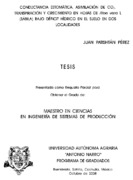Mostrar el registro sencillo del ítem
Conductancia estomática, asimilación de co2 transpiración y crecimiento en hojas de aloe vera l (sábila) bajo déficit hídrico en el suelo en dos localidades
| dc.contributor.advisor | Jasso Cantú, Diana | |
| dc.contributor.author | Patishtán Pérez, Juan | |
| dc.contributor.other | Rodríguez García, Raúl | |
| dc.contributor.other | Benavidez Mendoza, Adalberto | |
| dc.date.issued | 2008-10-02 | |
| dc.identifier.uri | http://repositorio.uaaan.mx:8080/xmlui/handle/123456789/3873 | |
| dc.description | Bajo condiciones sin sequía, las plantas de Aloe vera L tiene un comportamiento similar a las especies CAM nativas de las zonas semiáridas, las condiciones de temperatura fresca en la noche favorecen en la apertura estomática, asimilación de CO2 y transpiración. | |
| dc.description.abstract | ""El objetivo del presente estudio fue analizar el efecto de dos localidades en la conductancia estomática, asimilación de CO2, transpiración y crecimiento en Aloe vera L (sábila), así mismo su tolerancia a la sequía, con el fin determinar el clima que favorece mayor asimilación de CO2, crecimiento y la capacidad de la planta a soportar condiciones de sequía. Las mediciones de conductancia estomática, asimilación de CO2 y transpiración se realizaron durante 24 h a intervalos de 1.5 a 2 h. Se utilizó un equipo portátil para medir fotosíntesis (LICOR LI-6400 SYSTEM). El crecimiento de las hojas se estimaron por medio de la ecuación propuesto por Hernández et al., 2002. Los resultados muestran que en ambas localidades en las plantas sin sequía se presentaron las cuatros fases clásicas de asimilación de CO2. Bajo el clima de Buenavista la conductancia estomática, asimilación de CO2 y transpiración fueron mayores en un 39%, 25% y 11..5% respectivamente que en Marín, debido a las temperaturas más frescas. La sequía redujo hasta un 43% la conductancia estomática, 85% la asimilación neta de CO2 y 64% en transpiración. Como respuesta al estrés hídrico las plantas presentaron la variante CAM-reducido. Las temperaturas más frescas durante la noche en Buenavista promueven mayor apertura estomática, asimilación de CO2 y transpiración que en Marín. La sábila no mostró capacidad para soportar condiciones extremas de sequía. Las condiciones más cálidas de Marín favorecen en el crecimiento, debido a que las temperaturas altas promovieron el cierre estomático y de esta manera la pérdida de agua por transpiración fue disminuida El crecimiento diario y el rendimiento total fueron porcentualmente de 24% y 30% mayor en Marín. El déficit de humedad en el suelo, provocó una disminución de crecimiento diario y rendimiento total de 50% en Marín, y 47% en Buenavista. Ambas localidades, las plantas bajo condiciones de déficit de humedad en el suelo presentaron síntomas de sequía, por lo tanto la sábila no soporta condiciones extremas de sequía, comparado con otras especies como Opuntia ficus-indica, Agave deserti y Agave tequilana" | |
| dc.format | ||
| dc.language | Español | |
| dc.publisher | Universidad Autónoma Agraria Antonio Narro | |
| dc.rights | Acceso Abierto | |
| dc.rights.uri | CC BY-NC-ND - Atribución-Nocomercial-SinDerivadas | |
| dc.subject | CIENCIAS AGROPECUARIAS Y BIOTECNOLOGÍA | |
| dc.subject.other | Sábila | |
| dc.title | Conductancia estomática, asimilación de co2 transpiración y crecimiento en hojas de aloe vera l (sábila) bajo déficit hídrico en el suelo en dos localidades | |
| dc.type | Tesis de maestría | |
| dc.description.abstractEn | "The goal of this study was to analyze the effect of two locations in the stomatal conductance, CO2 uptake, transpiration and growth in Aloe vera L (sabila), so its tolerante to drought, determine the climate that further greater CO2 uptake, growth and the ability of the plant to withstand drought conditions. Measurements of stomatal conductance, CO2 uptake and transpiration took place during 24 h at intervais of 1.5 to 2 h. It used a portable device for measuring photosynthesis (LICOR L1-6400 SYSTEM). The growth of the leaves was estimated by of the equation proposed by Hernández et al., 2002. The results show that in both locations in plants well-watered were showed four phases classic CO2 uptake. Under the weather conditions of Buenavista, the stomatal conductance, CO2 uptake and transpiration were higher in a 39%, 25% and 11.5% respectively than Marín, due to the colder temperatures. The soil water deficit reduced until a 43% the stomatal conductance, 85% the CO2 uptake and 64% in transpiration. In response to the water stress, the plants showed the variant CAM-idling. The colder temperatures during the night in Buenavista promote greater openness stomatal, CO2 uptake and transpiration that Marín. The sábila doesn't showed ability to withstand extreme conditions of drought. The warmer conditions of Marín further on growth, due to high temperatures promoted the closure stomatal and in this way the loss of water by transpiration was diminished. The growth daily and the total yield were proportion of 24% and 30% higher in Marín. The soil water deficit caused a reduction of growth daily and total yield of 50% in Marín, and 47% in Buenavista. Both locations, the plants under soil water deficit showed syrnptoms of drought, thus the sabila doesn't tolerate extreme conditions of drought, unlike with other species as Opuntia ficus-indica, Agave deserti y Agave tequilana" | |
| dc.type.version | Versión publicada | |
| dc.audience | Estudiantes | |
| dc.audience | Investigadores | |
| dc.publisher.place | Saltillo, Coahuila, México | |
| dc.type.thesis | Digital |
